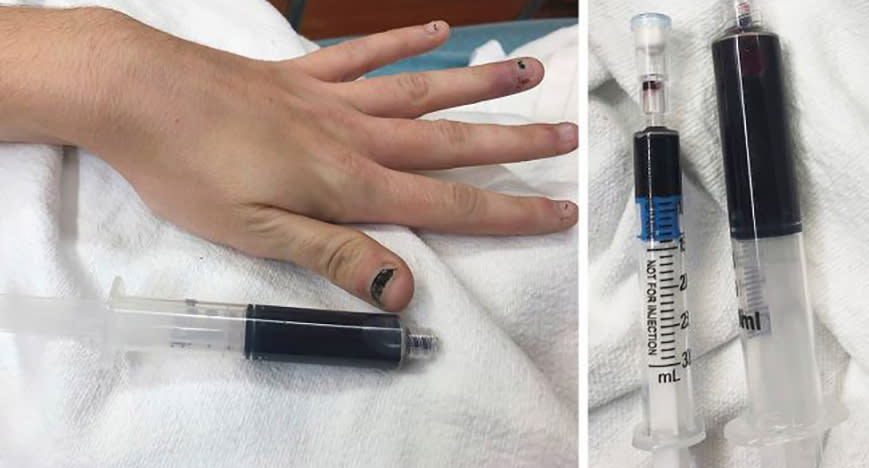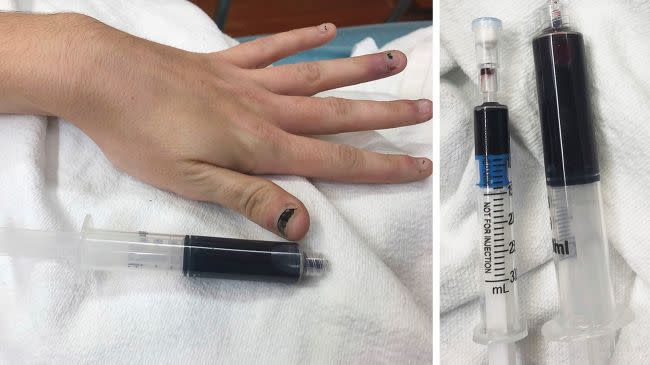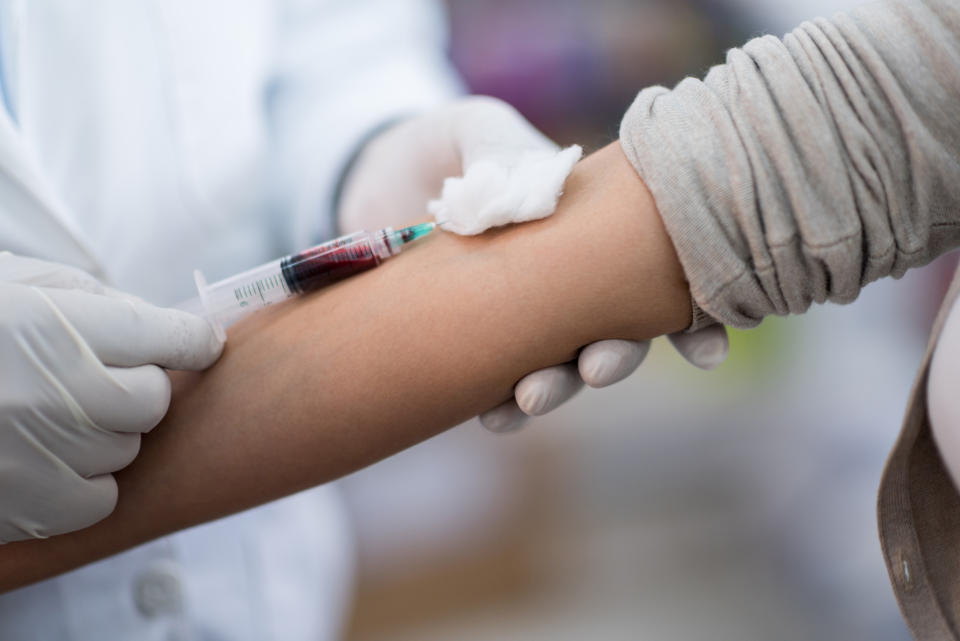What The Health? Woman's blood turns blue after developing rare disorder
Can leftover spaghetti really kill you? Can you actually cough up a blood clot in the shape of your lung? In Yahoo Lifestyle Canada‘s newest series, What The Health?!, we ask doctors to weigh in on odd health news stories and set the record straight. Be sure to check back every Friday for the latest.

“Blue blood” is a phrase sometimes used to describe a person of nobility, not as a literal term—but an American woman ended up in hospital after her blood had literally turned blue.
After being admitted to the emergency department in Rhode Island, the 25-year-old had blood drawn and instead of it being bright red, her blood was a deep navy blue. The odd shade could even be seen beneath her fingernails and her skin appeared bluish as well.
According to a new case report in the New England Journal of Medicine, the unnamed woman had developed a rare and sometimes fatal condition called methemoglobinemia.
ALSO SEE: What The Health?!: Doctors say man murdered his mother during 'cannabis induced psychosis'
The woman had used a topical benzocaine, an over-the-counter pain reliever, for a toothache. The next morning, she woke up feeling unwell and noticed her strange colouring.

“I’m weak and I’m blue,” she told doctors, NBC reported. Physicians described her as “cyanotic”, a medical term that indicates a blueish hue on the skin and nails and as a sign that the body isn’t getting enough oxygen.Indeed, her blood oxygen level had dropped to 67 percent from close to 100 percent. Having oxygen level that low can cause tissue damage.
While benzocaine acts as a numbing agent, the medication can also lead to methemoglobinemia, a blood disorder.
Here’s a basic rundown: hemoglobin, a protein that’s attached to red blood cells, carries oxygen throughout the bloodstream and releases it to the body’s cells. Methemoglobin is a type of hemoglobin that carries oxygen throughout blood as well, but doesn’t release it to the cells. If the body produces too much methemoglobin, it can begin to replace normal hemoglobin, depriving cells of oxygen.
ALSO SEE: What The Health?! Woman's arms and legs amputated due to infection from dog saliva
There are two types of methemoglobinemia: acquired and congenital, or present at birth.
In this case, the woman had apparently used large amounts of benzocaine. Luckily, her attending physician immediately recognized her condition, having seen it once before and knew how to treat it.
The drug methylene blue, also known as methylthioninium chloride was administered intravenously, and the woman began to feel better within minutes. After spending the night in the hospital for observation, she was sent home.

“It’s a rare reaction to certain medications—a handful of them can cause it—that chemically modifies hemoglobin, the oxygen carrier in our blood, so that it doesn’t deliver oxygen properly to the body,” says Dr. Peter van den Elzen of the department of pathology and laboratory medicine at the University of British Columbia and BC Children’s Hospital Research Institute. “It actually modifies hemoglobin, specifically the iron within hemoglobin, so it binds to oxygen tighter than normal and it won’t let go when it is supposed to, namely in the body’s tissues.”
ALSO SEE: What The Health?! Man finds shark tooth embedded in his foot from 24 years ago
Benzocaine can also be found in anti-itch creams, sprays to relieve sore throat, creams to relieve the pain of mild burns, insect bites, hemorrhoids and mouth gels for tooth pain and canker sores. It’s also used as a desensitizer in sexual enhancement products. Other forms of the medication are swabs, liquids, and lotions. There are lozenges as well, but the risk of methemoglobinemia hasn’t been associated with them.
In 2011, Health Canada reminded Canadians of certain health risks associated with benzocaine products. The following year, it requested that drug companies add new risk statements to the packaging and labels.

Those statements include seeking medical attention for symptoms such as weakness, confusion, headache, difficulty breathing, and/or pale, gray or blue skin. Signs of methemoglobinemia can appear up to two hours after use. The substance should not be used in large amounts or over large areas of the body.
Anyone experiencing any unusual signs and symptoms as a result of taking any medication should get medical care right away, van den Elzen notes.
“In this case, having the skin turn bluish and feeling terribly fatigued and weak should be concerning enough for someone to immediately seek medical attention,” van den Elzen says. “It is readily treatable.”
Let us know what you think by commenting below and tweeting @YahooStyleCA! Follow us on Twitter and Instagram.



